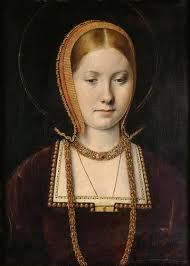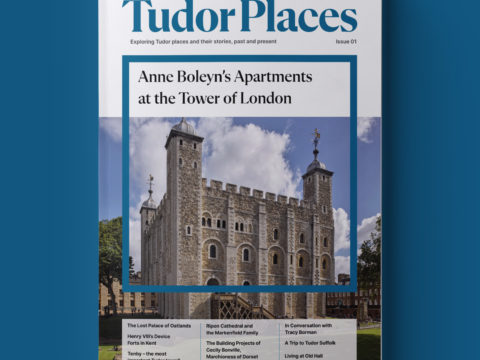Mary, Queen of France: Life Story
Chapter 3 : Princess of Castile
In December 1507, Henry’s minister, Richard Foxe, Bishop of Winchester, negotiated a final treaty with Maximilian. Like most treaties designed to be broken at whim, it was announced as a treaty of ‘perpetual peace’ between England and Maximilian. It was to be sealed with the marriage of Mary to Archduke Charles. The proxy wedding would take place the following Easter, and the marriage ‘per verba de praesenti’ within 40 days of Charles turning 14 (which would be April 1514).
Immediately after the marriage, Henry would pay for Mary’s journey to Helvoetsluys where the final ceremony would take place within eight days. The princess’ dowry would be 25,000 crowns. This was a low sum, but presumably took into account Maximilian and Philip’s enormous debts to Henry. Calais stood surety for the payment of the dowry. If either party failed, other than through the death of one of them, a fine of 25,000 crowns would be payable.
Mary’s dower (her income during marriage and widowhood) was to be the equivalent of that her great-aunt, Margaret of York, had been allocated when she married Duke Charles the Bold of Burgundy in 1468, and then increased when Charles inherited the kingdoms of Castile and Aragon.
Maximilian entered the treaty eagerly, in order, as he told his daughter, Archduchess Marguerite, to ‘get a good sum of money’. Archduchess Marguerite herself bluntly refused to entertain the idea of marrying Henry VII, but a marriage between Archduchess Eleonora (eldest daughter of Philip and Juana) with Prince Henry was also agreed.
Henry VII was delighted to hear the treaty had been signed. He ordered celebrations in the city of London, announcing that, with the marriage of his elder daughter, Margaret, to the King of Scots, and now Mary to be married to the Duke of Burgundy, and future King of Spain, he had preserved the safety of his realm: the country was now ‘in manner closed on every side with mighty princes, our good sons, confederates and allies’.
Mary’s likeness was captured in a bust sculpted by Pietro Torregiano (who later sculpted the tomb of Henry VII and Elizabeth of York). It was sent to Burgundy for the seven-year-old Charles to see his future wife’s face.
The marriage contract was signed by Maximilian on 22nd February 1508, but the proxy marriage, intended to happen by Easter, was delayed. It was not until November that all the details were agreed, and Charles’ proxies arrived in England. The delegation was headed by John III of Glymes, Lord of Bergen op Zoom, and a member of the Order of the Golden Fleece, together with numerous other dignitaries.
They were met at Dartford in Kent, by the Archbishop of Canterbury, William Warham, the Earls of Oxford and Shrewsbury, the Bishop of Worcester, Silvestro Gigli and 150 horsemen. The party spent two days in London, recuperating, before going downriver to Greenwich, for the formal introduction to King Henry, and Prince Henry. Mary is not mentioned as being present, when it was proclaimed the treaty was inviolable, and only death could prevent its fulfilment. In that lamentable case, the remainder of the treaty would stand, assuring the signatories of peace and prosperity.
On 17th December, the proxy wedding took place at Richmond. Mary was given the queen’s apartments, previously occupied by her mother. The presence chamber was draped with cloth of gold, as was the king’s presence chamber, where the Burgundian nobles assembled shortly after dawn. The king led them to Mary’s rooms, where the English nobles were waiting, and seated himself on a chair of state. Mary entered, accompanied by Katharine of Aragon. This must have been awkward for Katharine, whose betrothal to Prince Henry had been repudiated, in favour of the match with Archduchess Eleonora.
Mary was led to a covered dais, with Katharine beside her, but placed lower. The Archbishop of Canterbury, and then Jehan la Sauvage from the Burgundian delegation, delighted everyone for some time as they pontificated on the virtues of marriage in general, and this marriage in particular.
Lord Bergen produced his proxy authority from Charles, and confirmed that he was willing for the wedding to proceed. Bergen and Mary exchanged vows. She promised to take ‘the most high and puissant Prince Charles, by the grace of God Prince of Spain, Archduke of Austria and Duke of Burgundy’ as her spouse, vowing that during her natural life she would ‘have, hold and repute him for her husband’. The vows were made in French, and Mary repeated them perfectly.
It was a splendid match – in all likelihood, Charles would be elected as Holy Roman Emperor on the death of his grandfather and Mary would be the highest-ranking woman in Christendom. Henceforth, Mary was referred to in all letters and documents at the Princess of Castile. She is not to be confused with her sister-in-law – Katharine was always referred to as the Princess of Wales, or my lady Princess.
Following the ceremony, Henry and his ministers left to undertake further paperwork, followed by a gargantuan feast, which the ladies did not attend. The meal over, the gentlemen waited on the Princess of Castile, and the Princess of Wales in a gallery, where the ladies were preparing to watch more jousting – a three-day event.

Finally, there was a closing dinner. The Princess of Castile was given three gifts of jewels from her new in-laws. Maximilian sent a ruby, diamond and pearl ornament, Charles an ornamental ‘K’ for Karolus (Charles in Flemish), garnished with diamonds, and with a Latin inscription. Archduchess Marguerite’s gift was another ruby and pearl item.
It is this use of ‘K’ that leads art historians to suggest that the painting commonly thought to be of Katharine of Aragon, by Michel Sittow, in fact depicts Mary.
Since both women had hair of some shade of red, there can be no certainty, but Mary was acclaimed for her beauty in a way that Katharine never was.
Charles also sent a letter, which, given its matter-of-fact tone was probably the work of his own eight-year-old mind.
Mary, Queen of France
Family Tree


